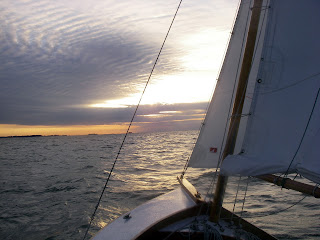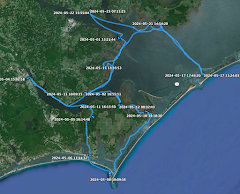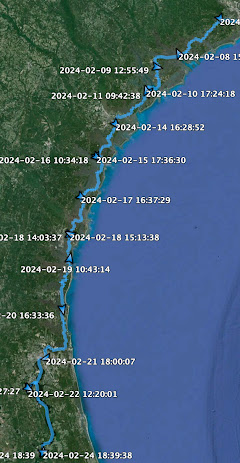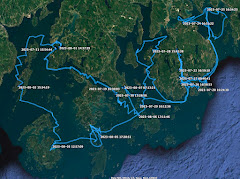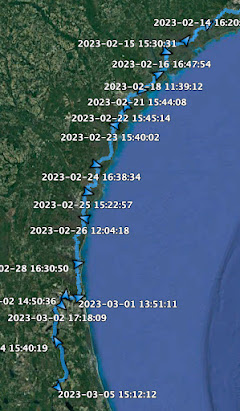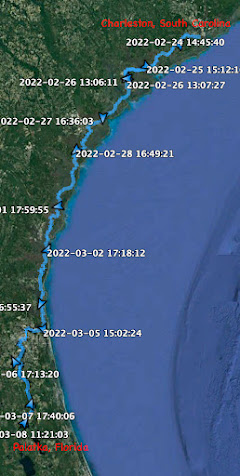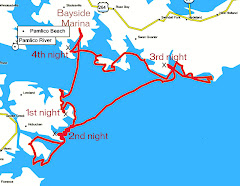Monday, January 31, 2011
that was quick
I placed the order with amazon yesterday at 3 or 4 in the afternoon, the camera was sitting on my doorstep this evening. Talk about good service.
There is the old Pentax Optio W20, top and the new Pentax Optio W90 below. I'm really happy with the photographs I got with the old W20. A good number of images on this blog were shot with that camera. I can only hope the new one will do as well.
Initial impressions....the new camera is lighter probably because of a molded polycarbonate plastic body as opposed to metal construction of the old body........good seal and lock around the small door that is the access for battery/storage card.......lots of rubber cushioning on the corners and edges of the W90 to make it more impact resistant.....the wide angle on the W90 is noticeably wider that the W20 (great for on a small boat), the maximum optical zoom on the W90 is slightly longer (giving a tighter image) than the W20.....I had thought I would like the strap with carabiner that comes with the W90 but once I had it on there it felt clumsy, sticking out where my right hand grasps the camera, so I took it off and replaced with the wrist strap.
So as far as sitting around in the kitchen, it is a great camera. Give me about 30 more degrees and a nice breeze and I'll tell you how it works on the water.
steve
Sunday, January 30, 2011
a new camera
I finally ordered a new camera, the Pentax Option W90 from Amazon. I've been researching this for months trying to figure out what was the best way to go for a waterproof camera. There were five or six in contention but after readying and comparing all the reviews I think this one is the best choice for me.
Part of that is based on the Pentax Optio W20 that I've used on Spartina for about four years. I bought that one based on a recommendation by Kiwibird after she used one for an Everglades Challenge. It worked well until this past fall when it started draining batteries regardless of whether the camera was turned on or not.
While these cameras are listed as waterproof to 20 feet I still consider them "water resistant" and not "water proof." I don't plan to take it underwater. I just want a camera that can take the rain, salt spray and occasional drop on the deck and keep on working.
I've been leaning towards the camera for a while and have been watching the prices trying to get the best deal. Watching the prices have been like watching the stock market. The values have been continually changing. I ordered today because the green model (which goes with Spartina's hull color), above, dropped down to under $200. The black version, which had been under $200 for a while, went up to $214. And the orange version is at $449.95. Go figure. When I first started researching the cameras the orange model, with an infared remote trigger included, was going for just about $200. I should have bought futures in those cameras at that price.
I also ordered a second battery, going with the original Pentax battery as opposed to the cheaper off brand batteries. My sailing friend Paul, aka Danceswith SandyBottom, who also used a Pentax Optio camera, told me he had better luck with the Pentax batteries and in his opinion were worth the price.
That's one more job I can take off the list of things I need to do to be ready for a March launch.
steve
the last winter coat
Sunny and almost 50 degrees today. Even warmer on our west-facing front porch. Warm enough to get the last coat of varnish on the mast.
As cold as it has been this winter I've been worried about getting all seven coats on. But they are on there now. Next weekend I'll put the hardware back on - the track for the goose neck, eye straps and all the other stuff I took off last November - an excellent project for Superbowl Sunday while I'm waiting for the game to start.
I also trimmed down an anti-fatigue mat that I bought at the hardware store. I carry my rudder, tiller and boomkin on the sole of the aft cockpit of Spartina. I usually put a towel and some blocks of wood beneath them. But while trailering on the highways the things bounce around and that is a lot of wear and tear on the boat and the rudder/tiller/boomkin. So I thought I might line the sole with this rubber mat to absorb the shock. (Why do I carry those things in the boat when they would easily fit in the back of the jeep? Because I can't forget them if they are always kept in the boat. Nothing worse that getting to the ramp and realizing a crucial piece of gear is sitting back at the house. Been there, done that. Now I keep all the gear in the boat.)
This nice thick layer of rubber will be a nice cushion as we bounce down the highway. I think it will work very well. This mat runs back about two-thirds the length of the sole. I'll get a second mat before the season starts to cover the rest of the floor.
And yesterday I got my outboard back from Jim. Thanks Jim! I haven't cranked it up yet, I'll probably do that mid-February. I don't see any point in buying fuel now and letting it sit around for over a month before I start sailing. But I have no doubt that the outboard will run like new.
While on a road trip last week I had some time to spare so dropped by an outdoor shop up in Richmond to pick up this Sea to Summit waterproof bag, just the right size to carry the spare gps and radio. Bruce has a handful of these bags on board and the are just right for small items like first aid kits, etc. I don't think you can have too many dry bags on a boat.
Things are coming a long. I think I can even see a light at the end of the long dark tunnel called winter.
steve
Saturday, January 29, 2011
under the big top
Jim posted a comment the other day asking about Spartina's boom tent. Here are some photographs of it in use. The tent is made out of white polytarp, three inch wide polytarp tape, double sided tape, some rope and bungee cord. I suspect I got the idea from Duckworks but can't find the article right now. Total cost was about $60.
The photo above is from my first cruise, a solo trip on Tangier Sound. Below is from a trip with Bruce around Cedar Island in North Carolina (I still remember sitting there that evening listening to the dolphin swimming around outside the boat, I could hear the gentle spouting as they surfaced to breathe).
Those trips were before we discovered Alpine Bivys. On those first couple of cruises, pre-bivy, we set up the boom tent every night. It kept the rain and dew off us. But it did not stop the mosquitoes (you can see the aft end is open). And, if there was no wind, it got hot. Worst of all, it blocked the view of the beautiful night sky. It really wasn't a very good shelter for a typical night on the water.
Now the bivys are the standard shelter on Spartina. They are cooler, keep mosquitoes out and at the same time you can look up through the mosquito mesh and enjoy the stars. I've mentioned the bivys in several posts including this one. But the tent is along on every cruise for those rainy nights and also when Spartina is tied up at a marina.
My friend Jim (not the mechanical Jim, the other one) from down the street helped me put it together one afternoon. A bolt rope runs down the peak of the tent, the forward end connecting to the main mast at the goose neck, the aft end gets tied to the mizzen mast. You can see the bolt rope in the peak in the photo above, plus one of the three grommets with bits of line that wrap around the furled main, boom and gaff.
Along the bottom edges of the tent are another series of grommets with bungee loops tied into them. The bungee lines hook onto inverted fender hooks (available at Duckworks).
As I mentioned, we always have the boom tent along and set it up when the boat is tied up at a dock or a marina. There is always some gear left on board and we figure it helps hide the stuff a little bit from folks walking by (the outboard is always locked in place and the valuable gear is carried with us up to the hotel room, but there are boat cushions, fishing gear, camp stove, etc). Plus it helps keep out rain. (On the Tag Team sail I neglected to set up the tent at the marina in Beaufort and of course a huge thunderstorm came through that night and I spent a good while pumping rain water out of the boat the next morning.) Below you will see Spartina, with boom tent in place, tied up at the public dock in Oriental, one of my favorite stopping places.
The heaviest rain we've experienced on board was on day two of the Crab House trip when we were anchored off of Punch Island Creek. I did not a very good job of tensioning the tent the night before and we did get some water in the boat and one side of the tent formed a nice little pool of rainwater, but nonetheless we stayed dry and comfortable in the bivy's. That is me below, a nice photo from Bruce, showing me getting ready to tuck the folded boom tent up under the foredeck where it lives during the day. Bungee lines hold it up under the deck where it is both out of sight and out of the way. (Some people say "How would we ever live without the internet?" I say "How would I ever live without bungee cord?")
So the boom tent is always on board, but used only when needed. I think I spent about 25 days cruising this past year and put the tent in place just twice, once at the marina in Oriental and again in New Bern. But when sleeping on board I some how avoided the rain and did not need to use the tent at all while anchored out. It is one of those pieces of gear that I'm glad to have on board to use when I need it, but only use when I really need it.
steve
Wednesday, January 26, 2011
day four of the spring trip
This is probably the easiest day of the trip to plan. From Whitehaven west and then north onto the Honga River. Trip, as measured out on google earth, is about 30 miles.
The main goal would be to get across the top of Tangier Sound, enter Hooper Strait and sail north into the Honga River. That is the Hooper Island Light, below, from day two of the Bay Days sail. Once we get there we head north on the river and there are countless anchorages on either side.
If we make good time we might head into to Hoopersville and get some lunch. But we'll most likely be too late for that.
As for the Honga, lots of coves, rivers and bays. Easy sailing (famous last words). But that would be the goal - get into the Honga River and head north from there.
steve
update from the outboard cam
Jim down the street sent me a couple of more photos of work on my outboard. He had the carburetor cleaned and ready to go. Next on the list was the waterpump. I had replaced the impeller a couple of years ago myself. It was, like most things I take apart, easy to disassemble, difficult to put back together. I'm sure Jim had a much easier time than me.
The impeller on the small outboard, 3 and 1/2 hp, is located in the little housing on top of the lower unit in the photo above. And below you can see Jim's photo of the gasket and both new and old impellers.
Jim says he has had it up and running in his shop and things are in good shape. He just needs to check all the connections and fittings and it will be ready to go. Thanks for the nice work Jim.
Below you see Bruce filling in his log book when we were anchored off of Wainwright Island at the top of Core Sound on our first cruise together back in '07 I think. And to the right of him is the trusty outboard. I've had lots of discussions, online and in person, with other sailors about outboard vs. no outboard. As far as I'm concerned it is a necessity for the kind of trips we do. We use it as little as possible, but when we do use it we are very glad to have.
By Saturday I'll have the outboard back and can check that off the "things to do" list. I've been focusing on cruising plans the last week or so but now I think I better make a list of things I need to do to be ready for day sailing starting in March. It's not that far away.
steve
ps - if you like good food check out the fun "food is love" post at Baydog's blog. Lots of good images of food. I'm proud to say I was involved in a couple of those meals. Enjoy!
Monday, January 24, 2011
it's like putting a puzzle together
The fun, at least to me, of planning a trip is putting all the little pieces together. A good ramp where you can leave the car and trailer, a few good anchorages spaced out along the route, a place to get fuel and resupply, a hotel somewhere along the way and maybe even a good meal at a restaurant.
I emailed The Whitehaven Hotel today asking about the chances of getting a room without a reservation mid-week in May. No problem, they said. And how about a restaurant within walking distance. No, but the not too far away restaurant The Red Roost will pick us up and drive us there for dinner. Pretty cool.
One more piece of the puzzle in place. I can taste the fresh steamed crabs already.
steve
a long cold winter
This long, cold, snowy winter isn't helping with the off-season boat work I should be doing. We dodged last weekend's storm but I heard that parts of the Outer Banks had six inches of snow. You can read about it here at the Island Free Press. There's a nice photo gallery with the story.
And the photo above is from TownDock.net in Oriental. Nice package of snow photographs there too.
Yes, lots of nice snow photos. But now that I think about it I'm ready for some nice Spring photos.
steve
the Wicomico River
If wind and weather cooperate we would use the third day to get to the little town of Whitehaven on the Wicomico River. I've measured out the distance below from South Marsh Island and it is about 18 miles. Just about right to get us in by early afternoon so we can look around, clean up and relax.
There is the very classic looking Whitehaven Hotel where we would like to stay for a night. You'll see photos of it down at the bottom of the post. And here is a photo of the old Whitehaven Shipyard from the hotel's website. Like all the little waterfront towns on the bay, there is a lot of history there. It was at one time a thriving little town. I'm sure it is much quieter now, but still it will be fun to look at the waterfront and imagine what it was like in days gone by.
That satellite photo at the top shows the route from South Marsh Island to Whitehaven. But as I said in yesterday's post we could end in at Deal Island instead of South Marsh Island. If we do end up at Deal Island we would have a choice of two routes to get to Whitehaven. One would be to sail west back out on to Tangier Sound. The other would be to head east and then north using Laws Thorofare to cut through the salt marshes behind Deal Island as drawn below. I always enjoy taking those narrow passages. We'll just have to see where we end up spending the night and what the weather is like.
And below is the hotel. Pretty nice looking place don't you think? I've emailed the owners checking on room availability and meals.
Drawing out these routes, measuring the distances helps me think through the trip. I can kind of see it all coming together now. A few days on Tangier Sound, then work our way up to the Little Choptank and then maybe Tilgman Island, Oxford and..... well we've still got to figure that out.
steve
Sunday, January 23, 2011
and then the day after that...
From Tangier Island we'll sail north to Smith Island and hopefully time it right to have a nice lunch at the Drum Point Market in Tylerton. I stopped there on day seven of the Bay Days trip and really enjoyed the lunch and a nice walks through the streets (lanes really) of the village.
We would be coming from the south entering the wide, shallow Tyler creek between Peachorchard Pt to the west and Horse Hammock, a salt marsh, to the east. The navigable part of the creek is a very narrow channel marked only by a few stick and pipes put out there by the locals. We've have two gps, including Bruce's with Garmin Bluecharts to help us stay in the channel.
After a visit to Tylerton we would like to continue north. There are three different paths we might follow to get through Smith Island and our choice of the route will probably be dictated by the wind. We could head west to Rhodes Pt and turn north to Sheep Pen Gut. We could take Tyler Ditch north from Tylerton to where it intersects with the Big Thorofare and head southeast to come out on Tangier Sound. Or we could take that same ditch north to the Big Thorofare and head west past the village of Ewell and then out on Chesapeake Bay. Bruce and I sailed the Big Thorofare from the sound to Ewell and then from Ewell to the bay a couple of years ago on the Crab House 150. It was a beautiful winding creek through the marshes of Smith Island.
So one way or the other, depending on wind, we'll end up either on Chesapeake Bay or Tangier Sound. The question is where do we go from there. If you look at the map at the top of this post you'll see I've got us going to Deal Island on the east site of Tangier Sound. The mileage on that route, as drawn in yellow, is about 28 or 29 miles. That sounds like a good distance for the typical cruising day.
Deal Island is home to at least one of the very few working Skipjacks. I caught a glimpse of this boat's sails on the horizon on the Bay Days trip. Wouldn't it be nice to sail into the harbor and get a closer look at her?
On days two and six of the Bay Days trip I was within a mile of Deal Island as I tacked across Tangier Sound but I was on my way to other places so I did not get to visit the place. Maybe this year. You can see my tracks from those to days below, and in the photo above I think that is Deal Island on the horizon as I sailed from South Marsh Island on the morning of day two.
Then again South Marsh Island could well be the stopping point for day two on the next trip. It just depends on wind and weather. The two islands are just about four miles from each other. I like having options of a couple of anchorage and I know from my last visit there that Little Pungers Creek on South Marsh Island is a very nice place to drop the anchor.
That's my gps and chart heading down Tangier Sound on the way to Little Pungers Creek, a decent 4.2 kts sailing into the wind and waves, reefed, with small craft warnings.
And there is the salt marsh that lines Little Pungers Creek. It is a shallow creek but provides good protection from wind from just about any direction but due east.
So day two could end at Deal Island or South Marsh Island. Those are at least two of the options - we like options - and a quick look at the charts shows there could be lots of other stopping places. But these are nice places for me to think about on a very cold winter day.
steve
Friday, January 21, 2011
the first day
Talking with Bruce about the trip got me thinking about the first day's sail. I had meant to put day-to-day sailing plans off until late February or early March, but we talked a bit and next thing I know I've got the Chesapeake Bay chartbook out and google earth is open on the computer.
We'll start out Onancock, lower right on the sat photo above, and head down winding, tree lined Onancock Creek, entering Chesapeake Bay as we pass by Parkers Marsh Wildlife Refuge (which in itself would be a nice place to visit on a weekender trip).
It is about a four mile run down to the Bay and then we turn NNW to enter Tangier Sound. There are two potential stopping points the first evening. Watts Island, above and below, or Tangier Island. We tend to keep that first day's sail a short one, 12 to 15 miles, as we'll already have started the day before dawn at my house, made a drive up the coast, rigged and loaded the boat. Driving, rigging, packing and then a few hours sailing is, for me, a full day.
Both Watts Island, 11 miles from Onancock, and Tangier Island, 15 miles from Onancock, fit the bill. I shot the photo approaching Watts Island in 2007 on my first ever cruise aboard Spartina. It is a narrow, sandy island with some trees and a few millions bird. The island runs north to south and does not offer a lot of protection. By "protection" I mean a nice little cove that would block the wind from at least three or four directions, say north, south and west. That way I don't have to worry about wind shifts in the middle of the night. Watts Island would be fine if the wind is out of the west or WSW, or if there is little or no wind at all.
The narrow little island once was large enough to support a plantation, but has since eroded away (like many of the islands on Chesapeake Bay). In fact at one time there was a Little Watts Island off the southern end of Watts Island with a lighthouse that marked the entrance to Tangier Sound. The lighthouse and Little Watts Island are long gone.
Below is a sat photo of Tangier Island. (Here is a post I did about Taniger Island a while ago.) This island offers a couple of good places to anchor. For years I've wanted to anchor inside the sandy hook (marked "XX" on the chart down below) at the southern end. Good protection there from the southwest, west and north. I've been on the island a few times for work and once took the long walk down that narrow stretch of beach to see the area marked as Cod Harbor on the charts and it was just beautiful. Bright white sand and clear water. To me that would be the ideal spot to drop the hook that first night.
If the wind is out of the north, northeast or east there is another good spot to anchor that I used on that first cruise on Tangier Sound. (Here are some more photos from that trip at Duckworks.) That is inside of the small island called Port Isobel. I've put an X where I anchored on that trip. You can see from the chart that it is a sand flat that for a lot of boats would not be considered navigable. But for a shallow draft like a Pathfinder it was perfect. I raised the cb and anchored in about two feet of water.
There is Spartina anchored on the sand flats, waiting for a front to coming rolling through that night. I did need the boom tent that night as the front brought both high wind and rains. But I was very comfortable, dry and warm inside my sleeping bag anchored out in protected water.
If you look close at the photo you can see the water tower and church spire in the village. I didn't get into the village on that trip. I don't know if we'll make it in there on this trip either. Smith Island and Tylerton are on the schedule for the second day of the trip and I certainly want to get to Tylerton in time for a nice lunch at the Drum Point Market.
That sounds like the start of a plan. Tangier Island for the first night, lunch the next day on Smith Island. Maybe Deal Island the next night. I need to look at the charts and figure that out.
steve
Tuesday, January 18, 2011
kind of like a nanny cam, but for outboards
Jim down the street (the mechanically oriented one) is working on my outboard this week. He told me he takes photographs as he works and he sent me a few this morning. It is kind of nice to be able to see what is going on.
There is a close-up of the gunked-up carb. I've used it for seven seasons now, both on my Pathfinder and the Nancy's China before that, so I guess it should be a little gunked up.
And there is a little bit wider view. I can do the basics on an outboard - change the spark plug, lower unit fluid and maybe even the water impeller. But this stuff is beyond me.
Jim says he is going over the entire outboard, looking for corrosion, wear and tear and any other problems. He did find this corrosion on the fuel line clamp, says he plans to clean that up for me. Plus lubricate all the fittings. Beyond that Jim will replace the water impeller, clean out the cooling water tube and replace the hydraulic fluid in the lower unit. It should be like new when I get it back.
Jim says the outboard might be ready to go in a week. I'll be glad to know that everything is in good shape. When out sailing I like to sail, but every once in a while that outboard can be a great help.
Thanks for the photos Jim, and thanks for the nice work.
steve
Monday, January 17, 2011
a couple more Welsford boats on the mid-atlantic
There has got to be an interesting story behind the boat below. It is a John Welsford Navigator called Bangarang!. I've never gotten the details of the story and as I do a lot of trailering with my boat I'm not sure I want to hear them anyway.
The boat was purchased by Andy, from North Carolina, from Maine. I've emailed with Andy a couple of times over the last few years, he tried to connect with us on the Skeeter Beater but it did not work out. A few months ago I get this email from him saying he had bought this boat and was having it shipped down from Maine and did I, by chance, know a marine surveyor that could provide "a fair market value" for the boat. The shipper, he said, was in an accident and was awaiting an "at fault" adjuster estimate. Ouch!
The next email I got from his was a few months later with the photo above attached. It looks like he got it down to North Carolina and had whatever repairs needed taken care of. I don't know the details of the accident or repair, just glad to see another Welsford boat on my part of the coast.
I'm also hearing that there is another Welsford boat in the works in South Carolina. This is a Pilgrim being built by Chip near Charleston. He says he hopes to have it on the water this summer. There aren't that many Pilgrims in the world right now, I wonder if this is the first one here in the U.S.
John came out with the Pilgrim design a few years after the Pathfinder. I've looked them over and it strikes me that the Pilgrim is a Pathfinder on steroids. It is about a foot shorter than the Pathfinder, but built much stronger with a lot more ballast. With a keel, steel centerboard and cutter rigged she must be a solid sailor. Plenty of space for two to sleep and, as typical with John's boats, plenty of room for storage. John says he was combining smaller boat design elements with some ideas from his bigger, offshore boats. It looks to me like it worked out pretty well.
I read where John once described the Pathfinder as a sports car while the Pilgrim was a 4x4. That may be true, I wrote John, but in that case I've had my Corvette off road more than a few times.
Chips, the boat looks great. I can't wait to see some photos of her on the water this summer.
Andy, enjoy the Navigator.
steve
Subscribe to:
Comments (Atom)



































